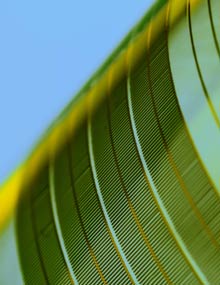Oct
7
The Smallest Solar Cell Goes Flexible
October 7, 2008 | 7 Comments
Sunday saw the journal Nature Materials prepublish on the website the abstract for John Rogers of the University of Illinois at Urbana-Champaign, and his team’s results in downsizing silicon solar cells with a new method to cut the chip off of the silicon crystal wafer.
The Rogers team offers a new way to process conventional silicon by slicing the brittle wafers into ultrathin bits and carefully transferring them onto a flexible surface. He says, “We can make it thin enough that we can put it on plastic to make a rollable system. You can make it gray in the form of a film that could be added to architectural glass. It opens up spaces on the fronts of buildings as opportunities for solar energy.”
Current silicon crystal solar cells are rigid, brittle and fragile, just not what much of the world needs for hail and wind resistance. Rogers said his technology uses conventional single crystal silicon. “It’s robust. It’s highly efficient.” The team uses a special etching method to slice the thin and tiny chips off the surface of a bulk silicon wafer. The sliced chips are 10 to 100 times thinner than conventional cells, and the size can be adapted to the application. That goes a long way to solving the durability issue.
When cut free a device picks up the silicon pieces “like a rubber stamp” and parks them on the surface material, Rogers said. “These silicon solar cells become like a solid ink pad for that rubber stamp. The surface of the wafers after we’ve done this slicing become almost like an inking pad. We just print them down onto a target surface.” The final step is to electrically connect these cells to get power out of them.
Rogers has been developing techniques for making flexible electronics over the past few years. The etched silicon pieces are bars about 1.5 millimeters long, 50 micrometers wide, and 15 micrometers thick carved from a wafer of monocrystalline silicon. The stamp is made of a soft polymer. It picks up the microcells and places them on a substrate, which may be glass or a flexible plastic, and then fabricates the interconnects. Rogers learned that a cell thickness of 15 to 20 micrometers struck a good balance: thin enough to be flexible, but thick enough to be mechanically stable and efficient, some 10% of conventional solar cells that use a layer of silicon 150 to 200 micrometers thick saving a huge proportion of the raw material and process from the raw wafer state.
The cell arrays have about 12% efficiency. The Rogers team increased the arrays’ power output by about two and half times by adding concentrators in the form of a layer of cylindrical microlenses in the top cover layer. Howard Branz principal scientist in the silicon materials and devices group at the National Renewable Energy Laboratory, in Golden, CO. said, “This is a nice start at using silicon wafers more efficiently.” The transfer-printing approach demonstrates for the first time how such thin cells could be manufactured on large areas.
Rogers says a major advantage of making solar-cell arrays using his transfer-printing process is the ability to control the spacing between the microcells. Sparse arrays of the cells are semitransparent and could be used as tinted, energy-producing window coatings. He also hopes that the thin solar cells will replace conventional solar cells on roofs and in other places where solar cells are already found.
These attributes of the team’s work could well offer more than just some added durability. The cells sets may well be cheaper to make transport and install than the current designs. Should the research progress in solving these matters that would overcome some of the barriers of much more widespread use of photovoltaic collectors.
The efficiency issue is actually quite good, but some including Branz, point out that to really affect the market, efficiency needs to get to 15%. Maybe, but the installed cost will establish the competitive efficiency. Reality will dictate better product as conventional cells can get past 20% now.
Rogers knows those conventional efficiency methods could be applied to the team’s microcells as well, although they have not yet focused on optimizing the material’s efficiency. The other bug is that flexible solar cells made from amorphous silicon, found market share at much lower efficiencies, but the bug might be a huge opportunity.
The technology has been licensed to a startup company called Semprius Inc in Durham, North Carolina, which is in talks to license the technology. “It’s just a way to use thing we already know well,” Rogers said. He envisions the material being “rolled up like a carpet and thrown on the truck.”
That’s the idea – durable, efficient and lower cost. This is progress.
Comments
7 Comments so far



[…] … to architectural glass. It opens up spaces on the fronts of buildings as opportunities for solar energy.” The Rogers Team Microcell Array Current silicon crystal solar cells are rigid, brittle and fragile, just not what much of the world needs for hail and wind resistance. Rogers said his … The Smallest Solar Cell Goes Flexible […]
Would you tell me how can I get this solarcell? And how much the costs?
kindly send me product profile & all the details.thanks.
let me know how to connect two 46 watts pannels.can i connect paralely
A.R.NAGARAJAN
LET ME KNOW HOW TO CONNECT TWO 46 WATTS PANNELS. CAN I CONNECT PARALELY.
A.R.NAGARAJAN
I am working on an idea related to the idea of power prodcuing window coatings mentioned in the article. I would love to discuss possible application of this type of device in regards to my theoretical designs. I can be contacted at my email of daemon30@hotmail.com or at either 780-619-5867 or 780-249-1469. Thanks.
My cousin recommended this blog and she was totally right keep up the fantastic work!